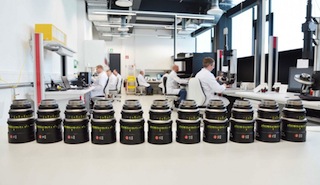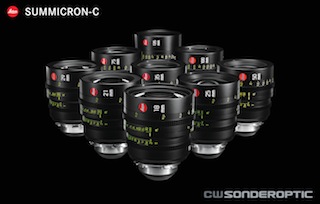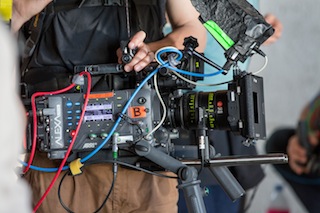 Even by itself a professional motion picture lens feels magical. Each one represents the painstaking work of many dedicated people who put their hearts and souls into the creation of a precision blend of metal and other materials encasing carefully polished glass. But, in fact it is simply a tool. What makes any lens truly special is how and why a filmmaker chooses it for a particular shoot and, especially, how he or she uses it. Put a great lens into the hands of a talented cinematographer with a trained eye and magic happens.
Even by itself a professional motion picture lens feels magical. Each one represents the painstaking work of many dedicated people who put their hearts and souls into the creation of a precision blend of metal and other materials encasing carefully polished glass. But, in fact it is simply a tool. What makes any lens truly special is how and why a filmmaker chooses it for a particular shoot and, especially, how he or she uses it. Put a great lens into the hands of a talented cinematographer with a trained eye and magic happens.
How and why a given DP chooses a specific lens for a particular shot involves a mix of objective and subjective factors that are unique to each shot, each individual. These decisions are being made every day by countless cinematographers around the world. Today, depending on your particular viewpoint, their choices are getting easier or more difficult.
A growing part of their challenge is the seemingly endless number of camera formats that are coming to market. Lens manufacturers face the same challenges but from a different perspective. In considering all these new formats and understanding the complex issues their customers face, they have to decide what lenses to make and how to bring them to market at a competitive price and in a timely fashion.
To understand this dynamic better Digital Cinema Report is presenting an ongoing series of conversations with the major professional motion picture lens companies. Today in this, part three, Digital Cinema Report spoke via email with Gerhard Baier, managing director and Seth Emmons, marketing director cine products, CW Sonderoptic.
Digital Cinema Report: What drives lens development at your company? Is it customer demand, products introduced by your competitors, or innovations discovered by your own designers? A combination of all of those? Something else entirely?
CW Sonderoptic: The main driver of our lens products is customer demand. This is followed closely by innovations from our own designers who work very hard to develop methods and technologies that push the limits of what is possible in the cinema optics world. We also have good relationships with many of the camera manufacturers and we try to follow their trends as well. Sometimes you have to anticipate the customers demand with what you know and they may not.
 DCR: What is the single biggest challenge in making a high quality professional lens?
DCR: What is the single biggest challenge in making a high quality professional lens?
CWS: Glass, glass, and glass. What we have found is that working at the top end you can either have performance-driven or cosmetically-precise lenses. Customers always want both, high performance and crystal clear when looking into the lens. If we focus on performance at the highest level then we have to compromise on the kinds of glass types available. Mechanics are another challenge because customers want smaller and smaller lenses, so squeezing the lenses into smaller housings puts a stress on the mechanics. Smaller lenses also put more stress on the performance of the optics.
DCR: How much time does it take to bring a new prime lens to market?
CWS: A high-quality prime lens takes about three years from conceptual design to initial production. An entry-level product could be done in under a year.
DCR: How much time does it take to bring a new zoom lens to market?
CWS: A zoom lens would take about the same amount of time, roughly three years.
DCR: Describe the steps in each process, prime and zoom.
CWS: Idea. Optical design. Verify. Mechanical design. Verify. Optical and mechanical design together. Test and adjust. Produce prototypes. Test and adjust. In short, test, test, test.
 DCR: To what extent has digital cinematography changed lens design and manufacture?
DCR: To what extent has digital cinematography changed lens design and manufacture?
CWS: It has definitely changed lens design because of the importance of telecentric output for digital sensors. Also, there is a different color space because of how sensors see colors. The balance between resolution and contrast has changed because digital sensors are looking more for resolution than for contrast.
Digital sensors are also more sensitive to relative field illumination and consistency over the entire field than film and it requires us to pay more attention to covering the whole sensor with an even amount of illumination. This is especially important as sensor sizes continue to grow.
DCR: Has there been a dramatic change in the kinds of lenses cinematographers request? If so, what?
CWS: Yes. Breakdown the sharpness and offer unique features or looks. The character of a lens has become more important because film stocks are no longer in wide use. That used to be how cinematographers put their mark on their work. Now the bulk of creative imaging choice falls on lenses. On the other hand, post-production is capable of more and more, but there is still a desire by many cinematographers to create the image at the point of capture. At the lower end of the market the request is for best performance at an affordable price.
DCR: How much of the lens-making process is still done by hand?
CWS: For the Summilux-C lenses, it is more than 70 percent. All of our centering is done by hand with the aid of machines to verify. Also, we center all of our glass elements in their mounts by hand. The Summicron-C lenses are designed to be easier to manufacture, but assembly is still done by hand.
DCR: Where are your lenses made?
CWS: They are assembled in Wetzlar, Germany and Japan.
 DCR: Where do you source your glass?
DCR: Where do you source your glass?
CWS: Deep in the pastoral fields of Wetzlar, Germany is a cave. About 300 meters below the surface sits an old man with a long, gray beard beside a spring of the purest water and from him we get our magical glass.
But more seriously, there are only a couple of manufacturers in the whole world that can create the high performance and complicated glass elements that we use. We are open to glass from anywhere, and raw glass is not so complicated to get, but the limiting factor is who can make it, who can handle it (painting, polishing, coating, matching doublets, cementing, etc.), and then making it work in the entire lens system.
DCR: What new lenses are you developing now?
CWS: We are adding additional focal lengths to both the Leica Summicron-C and Leica Summilux-C lens lines. We also have a few other new things in the pipeline that we are not ready to share at this time.
DCR: Will lenses always be analog or can you envision an all-digital high quality professional lens?
CWS: Right now the professional cine market is not ready for an all-digital lens. It will change everything about the camera-lens system, possibly more than the transition from film to digital capture.
With an all-digital lens you have to give the option of control to the people who are working with it. Think about the idea of auto-focus in cinema. It can be done technically but there is no demand for it. There are delays in the focus mechanism and other limitations that add up to a lack of control for the imagemakers. We are already seeing a push back from some cinematographers to limit the ability to reframe in post. Can you imagine the uproar if post was suddenly able to adjust focus and aperture? There would be riots on the studio lots.
Technologies like light field cameras and auto focus lenses are very interesting concepts, but they have to make sense in the creative process and not allow control of the image to be taken away from the cinematographer. I don’t think we are ready for that just yet.
The photo of the Leica factory is used courtesy of Jon Fauer © Film and Digital Times.
The links to the previous conversations are here:
Magical Glass: Part 1, Schneider-Kreuznach http://bit.ly/UIyuIz
Magical Glass: Part 2, Canon http://bit.ly/1pPxY6R
